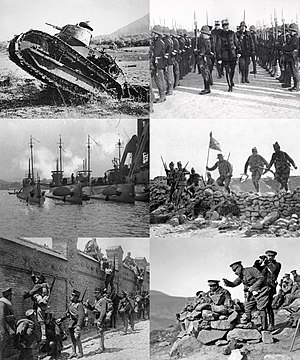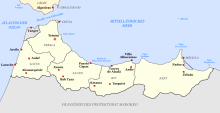Rif War (1921-1926)
| date | June 8, 1921 to May 27, 1927 |
|---|---|
| place | Rif Mountains , Northern Morocco |
| output | Spanish - French victory |
| Parties to the conflict | |
|---|---|
| Commander | |
|
|
|
| Troop strength | |
|
|
Spanish estimate: 80,000 Other sources: 35,000 to 50,000 |
| losses | |
|
30,000 dead and wounded |
|
The Rif War , also known as the Second Moroccan War , is the military conflict between the Rif Kabyls under Mohammed Abd al-Karim and Spain between 1921 and 1926 .
The Spaniards tried, based on the Treaty of Fez of March 30, 1912 and the Franco-Spanish Treaty of November 27, 1912, to extend their rule to the entire colonial area in northern Morocco that was assigned to them . In 1926 they finally succeeded in conquering the entire Protectorate area starting from their old bases on the Plaza de Soberanía coast . They threw over 10,000 mustard gas containers at their opponents , the effects of which continue to this day.
The First Moroccan War , also known as the Spanish-Moroccan War , took place as early as 1859/60 - it was the first attempt to expand Spanish influence in Morocco. After the Rif Wars of 1893 and 1909 , the Rif War from 1921 to 1926 was the last in a series of conflicts in the area of the Rif Mountains .
prehistory
By 1920 France expanded control over its part of Morocco and demanded that Spain completely occupy its protectorate area. In 1920 the Spaniards conquered the city of Chauen in the west of the Rif. They treated the Rifkabylen badly. Spain transformed Morocco into a “mixture of battlefield, brothel and tavern”, according to the Spanish writer Arturo Barea .
The war
From 1921 onwards, Spanish troops began to occupy the Spanish protectorate in the Rif Mountains under the propaganda pretext of a punitive expedition to capture the rebel Ahmed ben Mohammed el-Raisuli . The occupation was carried out hastily and without securing the supply lines.
The leader of the Berber tribes , Mohammed Abd al-Karim, sent a warning to Spanish general Manuel Fernández Silvestre that if he should cross the Amekran River it will be considered a declaration of war . The Spaniard nonetheless sent an advance party across the river, which was surrounded by around 1,000 rifabylums that afternoon, with 179 Spaniards killed and the rest of them retreating.
On July 22, 1921, the Spanish positions at Annual in north-eastern Morocco were attacked directly. Some 9,000 Spanish soldiers were killed in the three weeks of the Battle of Annual . After the disaster at Annual, there was a change in strategy on the Spanish side. For the poisoning with mustard gas planned by the German chemist Hugo Stoltzenberg , the central Rif was evacuated by the Spanish troops in an increasingly orderly manner by the beginning of 1925. In the west near Tétouan they withdrew behind a line named after Miguel Primo de Rivera and fortified it. In the east they defended a reduced area around Melilla .
In the euphoria of victory, the Rifkabylen proclaimed the Rif Republic in 1923 - the existence of which, however, contradicted European unification on the division of Morocco. An effective naval blockade was carried out against the Rif Republic. The French Minister of War Paul Painlevé reached an agreement with the dictator Miguel Primo de Rivera on June 17, 1925 in Madrid. On July 13, 1925, Philippe Pétain was appointed Commander-in-Chief of the French Rif Army. He had more than a hundred battalions, not counting the more than 350,000 Harkas des Majzen , the administration of the Sultan Mulai Yusuf . From 1925 onwards, 250,000 men under Pétain occupied the fertile areas in French Morocco and prevented the Rif Republic from being supplied with food. The Geneva Protocol , signed in June 1925, was violated in violation of international law by using over 500 tons or 10,000 containers of mustard gas against the area controlled by the Rif Republic .
On September 8, 1925, Spanish troops landed on the coast near Al-Hoceima . In the following year, the Spaniards advanced into the Rif, and the French advanced from the south. On May 27, 1926, Abd al-Karim surrendered to the French, a year later the last tribe of the Rifkabylen ended the fight.
“The French government tolerated the Spanish practices without criticism. She knew of the German-Spanish gas business without taking any action, because she wanted the war to be ended as quickly as possible. The British secret service also knew about the Spanish use of gas. Great Britain wanted to see Spain's situation in Morocco strengthened. This was about overriding British interests in the Mediterranean region. "
consequences
The use of mustard gas represented a breach of the Hague Land Warfare Regulations . The contamination with mustard gas meant that the area around Al-Hoceima still leads the lung cancer statistics in Morocco today . Victory came at the cost of sustained contamination of large areas and cost the lives of thousands of people.
The protectorate of Spanish-Morocco only existed until 1957. Then the Spanish troops withdrew to the old bases of the Plazas de soberanía .
literature
- Dirk Sasse: French, British and Germans in the Rif War 1921–1926. Speculators and sympathizers, deserters and gamblers in the service of Abdelkrim. in: Pariser Historische Studien Vol. 7, R. Oldenbourg Verlag, Munich 2006, ISBN 3-486-57983-5 .
- Fouzia El-Asrouti: The Rif War 1921–1926. A critical examination of the transformation processes under Muhammad Ibn Abd al-Karim al Hattabi. Klaus Schwarz Verlag , Berlin 2007, ISBN 978-3-87997-338-5 .
- Rudibert Kunz, Rolf-Dieter Müller: Poison gas against Abd el Krim: Germany, Spain and the gas war in Spanish-Morocco, 1922–1927 . Rombach-Verlag, Freiburg 1990, ISBN 3-7930-0196-2 .
- Daniel Cling: La guerre du Rif , Arte documentation, 2011.
- Jörg Tiedjen: Abdelkrim, the Battle of Anoual and the Rif War , published in: Inamo No. 26, year 7, summer 2001.
Individual evidence
- ↑ a b Jörg Tiedjen: Abdelkrim, the Battle of Anoual and the Rif War (PDF file; 70 kB).
- ↑ L'histoire oubliée des surréalistes et la guerre du Rif ( Memento of February 12, 2008 in the Internet Archive ) (French).
- ↑ Dirk Sasse: French, British and German in the Rif War 1921–1926 , p. 62 R. Oldenbourg Verlag , Munich 2006.
- ↑ The embellished official information on the Spanish side alone speaks of at least 17,020 dead and missing as well as 23,610 wounded (Dirk Sasse: French, British and German in the Rif War 1921-1926: Speculants and ... , p. 56).
Web links
- Literature on the Rif War in the catalog of the German National Library
- Article about the Rif War in ta mazight (rifisch)
- Radio feature on the Rifkrieg from WDR / DLF as audio on Deutschlandfunk and the manuscript (PDF | 1.1 MB) on WDR

